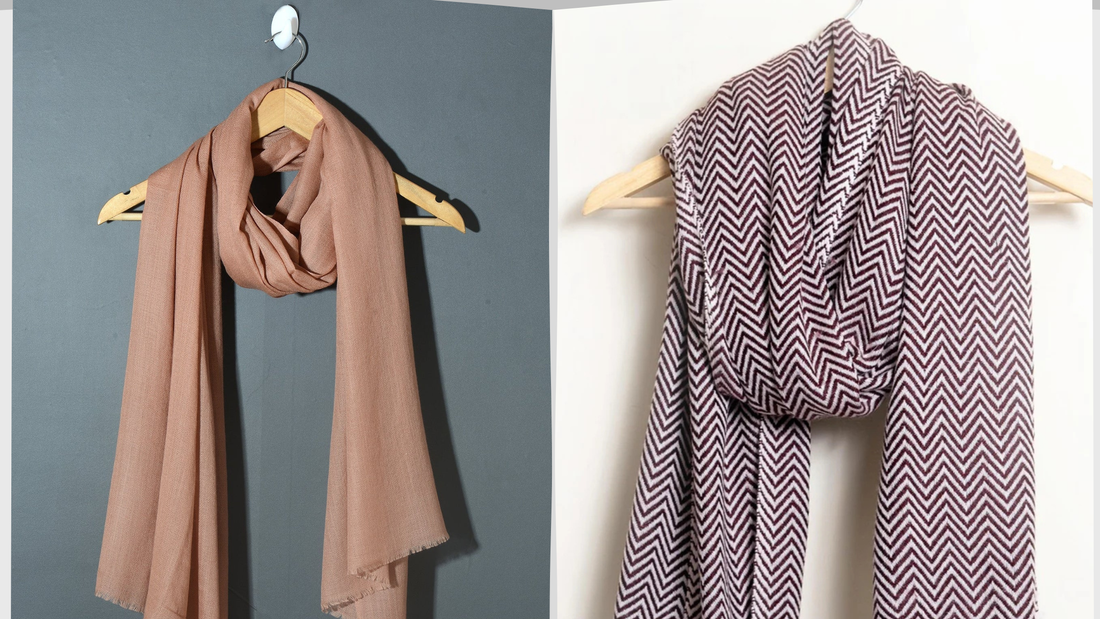
How Is a Pashmina Stole Different from a Woollen Muffler?
Pashmina has long symbolized luxury and craftsmanship. Many people mistake a Pashmina stole for a regular woollen muffler, yet both differ in origin, fiber, texture, and purpose. This guide explains how these two items compare, so you can make an informed choice when investing in fine accessories like OMVAI’s Pashmina Stoles.
What Is a Pashmina Stole?

Pashmina is a fine type of cashmere wool that comes from the undercoat of the Changthangi goat, native to the high altitudes of Ladakh. These goats grow soft, warm wool to survive extreme cold.
- The word “pashmina” comes from the Persian word Pashm, meaning soft gold.
- The fiber diameter is usually 12–16 microns, much finer than ordinary wool.
-
Each stole is handwoven by skilled artisans, often taking several weeks to complete.
A genuine Pashmina stole is soft, warm, and light. It drapes elegantly, making it ideal for both formal and casual wear.
What Is a Woolen Muffler?

A woollen muffler is made from regular sheep wool or synthetic blends. It is designed mainly for warmth and daily use.
-
Wool used in mufflers comes from various breeds of sheep.
- Fiber diameter is generally 20–40 microns.
-
It can be machine-made, allowing mass production at a lower cost.
A muffler serves a functional purpose. It protects from cold but lacks the luxurious texture and heritage of Pashmina.
Origin and Heritage
The story of Pashmina dates back centuries.
-
Pashmina weaving began in Kashmir, where artisans mastered the art of spinning and weaving the delicate yarn.
-
The process involves hand combing the fiber, spinning it on a traditional charkha, and weaving it on a wooden loom.
-
This heritage craft is recognized by UNESCO as part of India’s cultural heritage.
Woolen mufflers, on the other hand, have no defined origin. They are industrial products found globally, produced in factories with limited artistic involvement.
Fiber and Material Comparison
-
Source: Pashmina from Changthangi goats; woollen mufflers from sheep or synthetic fibers.
-
Fineness: Pashmina fiber is less than 16 microns, making it softer and lighter.
-
Warmth: Despite being thinner, Pashmina retains more heat due to its natural insulation properties.
-
Durability: With proper care, Pashmina lasts decades; mufflers wear out faster.
The natural fineness of Pashmina ensures breathability, warmth, and comfort unmatched by standard wool.
Weaving Process and Craftsmanship
Each Pashmina stole is a result of manual skill.
-
Spinning is done by hand using traditional tools.
-
Weaving is performed on wooden looms with precise craftsmanship.
-
Some are hand-embroidered with intricate needlework, adding value and uniqueness.
In contrast, mufflers are usually machine-woven. The process focuses on speed and uniformity, not artistic detail. This difference explains why Pashmina stoles cost more.
Feel and Appearance
-
Texture: Pashmina feels silky, light, and soft against the skin. Woollen mufflers often feel thicker or slightly coarse.
-
Drape: Pashmina falls gracefully, enhancing your outfit’s look.
-
Designs: Pashminas often feature hand-embroidered or woven patterns, while mufflers come in basic prints or checks.
-
Weight: Pashmina stoles are light yet warm, ideal for layering.
When you touch a genuine Pashmina, you immediately feel the difference in luxury and texture.
Price and Value
Pashmina stoles are premium items.
-
Handcrafting, rarity of material, and artisan skill make them more expensive.
-
A genuine Pashmina can cost several times more than a muffler.
-
Each piece is unique and often passed down through generations.
A woollen muffler for man is affordable and practical but lacks exclusivity and resale value. When you buy a Pashmina, you invest in art and tradition, not just clothing.
Durability and Care
A Pashmina stole requires gentle handling.
-
Dry clean only.
-
Store it folded in a cotton bag.
-
Avoid hanging it for long periods to prevent stretching.
-
Keep it away from moisture and direct sunlight.
Woollen mufflers are easier to maintain and can often be hand-washed. However, they tend to lose softness and shape over time. Pashmina, if cared for properly, becomes softer with age.
Identification and Authenticity
Genuine Pashmina has distinctive qualities:
-
Passes through a small ring due to its fineness.
-
Burns with a smell similar to burnt hair when tested with a fiber strand.
-
Feels soft, not slippery or synthetic.
Many imitations exist. Brands like OMVAI provide authentic, certified Pashmina stoles sourced ethically from Ladakh and woven by Kashmiri artisans.
When to Choose Pashmina vs. Woolen Muffler
Choose a Pashmina stole when:
-
You want elegance and luxury.
-
You attend formal events or weddings.
-
You want a versatile piece that complements both ethnic and western outfits.
Choose a woollen muffler when:
-
You need functional winter wear.
-
You want something durable for daily outdoor use.
-
You prefer a budget-friendly option.
Both serve different purposes, but only Pashmina offers a timeless appeal.
Why Buy Pashmina from OMVAI
OMVAI sources pure, handcrafted Pashmina directly from skilled artisans.
-
100% pure handwoven Pashmina from Ladakh.
-
Ethical and sustainable production.
-
Elegant designs in natural and dyed colors.
-
Light, warm, and soft texture.
Every OMVAI Pashmina stole tells a story of craftsmanship, tradition, and timeless luxury.
Conclusion
A Pashmina stole stands apart from a woollen muffler in every aspect. From origin and material to craftsmanship and feel, it represents heritage and luxury. A muffler keeps you warm, but a Pashmina adds grace, culture, and elegance to your wardrobe. When you invest in a genuine Pashmina, you buy more than fabric. You own a piece of art.
